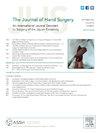手与腕片腕骨夹角:手x线片是否足以评估腕骨夹角?
IF 2.1
2区 医学
Q2 ORTHOPEDICS
引用次数: 0
摘要
目的:腕角传统上是在标准腕系列的横向投影上测量的;然而,这通常需要获得额外的放射影像,从而导致额外的辐射暴露和增加的成本。我们的目的是确定与腕关节x线片相比,标准系列手部x线片能否准确测量腕关节角度。方法:对3位上肢骨科医师对40例患者的腕关节指数进行了手侧位x线片测量。纳入标准为无代谢性疾病、无硬体、无骨折、腕部屈伸位等。结果:手、腕部x线片评分一致性分别为:SLA 0.746、0.763、RLA 0.918、0.933、RCA 0.738、0.538、CLA 0.825、0.650、RSA 0.778、0.829。对于RCA (0.738 [0.605-0.840] vs 0.538[0.358-0.700])和CLA (0.825 [0.728-0.896] vs 0.650[0.492-0.781]),评估者之间的一致性优于手片,但对于SLA、RLA或RSA则不一致。三名评分者中有两名对所有手部x线片测量具有出色的内部一致性(ICC范围,0.907-0.995)。结论:在手x线片上腕关节角度测量可靠,肩胛骨和腕关节屈伸关系良好。临床相关性:通过减少获得额外x线片的需要,外科医生可能能够降低成本和患者的辐射暴露。本文章由计算机程序翻译,如有差异,请以英文原文为准。
Intercarpal Angles on Hand Versus Wrist Films: Are Hand Radiographs Sufficient for Assessing Intercarpal Angles?
Purpose
Carpal angles traditionally are measured on the lateral projection of a standard wrist series; however, this often necessitates obtaining additional radiographic views resulting in additional radiation exposure and increased cost. We aimed to determine whether carpal angles could be measured accurately on a standard series of hand radiographs when compared to wrist radiographs.
Methods
Carpal indices were measured on lateral wrist and hand radiographs of 40 patients by three orthopedic upper extremity surgeons. Inclusion criteria were no metabolic disease, no hardware, no fractures, radiographic positioning of the wrist in flexion/extension <20°, minimum 3 cm of distal radius visible, and acceptable scaphopisocapitate relationship (defined as the volar cortex of the pisiform lying between the volar cortices of the distal pole of the scaphoid and capitate). Angles measured included radioscaphoid (RSA), radiolunate (RLA), scapholunate (SLA), capitolunate (CLA), and radiocapitate (RCA). Measurements on wrist versus hand radiographs were compared for each patient. Interclass correlation coefficients (ICCs) were computed to assess interrater and intrarater agreement.
Results
Interrater agreement for hand and wrist radiographs were (respectively): SLA 0.746 and 0.763, RLA 0.918 and 0.933, RCA 0.738 and 0.538, CLA 0.825 and 0.650, RSA 0.778 and 0.829. Interrater agreement was superior in favor of hand radiographs for the RCA (0.738 [0.605–0.840] vs 0.538 [0.358–0.700]) and CLA (0.825 [0.728–0.896] vs 0.650 [0.492–0.781]), but not the SLA, RLA, or RSA. Two of the three raters had excellent intrarater agreement for all hand radiograph measures (ICC range, 0.907–0.995). The mean difference in measured angles on hand versus wrist radiographs was <5° for all angles.
Conclusions
Carpal angles may be measured reliably on hand radiographs with an acceptable scaphopisocapitate relationship and wrist flexion/extension of <20°.
Clinical relevance
By mitigating the need to obtain additional radiographic views, surgeons may be able to reduce the cost and radiation exposure to their patients.
求助全文
通过发布文献求助,成功后即可免费获取论文全文。
去求助
来源期刊
CiteScore
3.20
自引率
10.50%
发文量
402
审稿时长
12 weeks
期刊介绍:
The Journal of Hand Surgery publishes original, peer-reviewed articles related to the pathophysiology, diagnosis, and treatment of diseases and conditions of the upper extremity; these include both clinical and basic science studies, along with case reports. Special features include Review Articles (including Current Concepts and The Hand Surgery Landscape), Reviews of Books and Media, and Letters to the Editor.

 求助内容:
求助内容: 应助结果提醒方式:
应助结果提醒方式:


